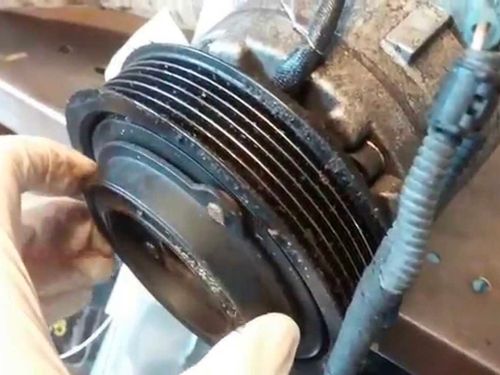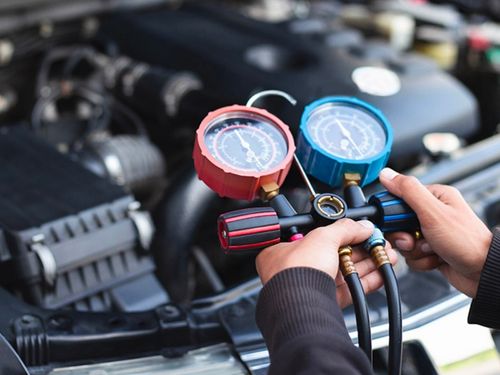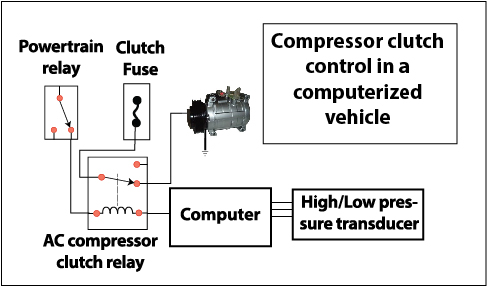Your car’s air conditioner is one of the most important components in keeping you cool during the hot summer months.
So, when you start to notice that your AC isn’t working as well as it used to, it can be a cause for concern.
One potential issue that you might be experiencing is that your AC compressor clutch stays engaged.
This can prevent your air conditioner from properly cycling and result in your car feeling warmer than usual. If you’re noticing this problem, there are a few possible explanations.

Table of Contents
How Long Should AC Clutch Stay Engaged?
On average, the compressor should stay on for 4-10 seconds and then off for 15-20 seconds. However, there are many factors that affect how long the AC compressor clutch stays engaged. The main factors are the outside and cabin temperatures, engine RPM, vehicle speed, AC system design, and how hot it is outside.
If you’re driving on a cool day with the fan at low speed, the compressor may only come on for a few seconds at a time.
But if you’re sitting in traffic on a very hot day with the fan on maximum speed, the AC compressor may not be able to keep up and may run continuously.
AC Compressor Clutch Stays Engaged: Causes & Fixes
If the a/c clutch stays engaged, there is a possibility that it may be seized. To check that, remove the A/C relay and see if the ac compressor clutch disengages. If the car ac clutch is still engaged, it means it is seized. Otherwise, use a set of manifold gauges to check your refrigerant pressure.
Low-pressure switch
The low-pressure switch is designed to prevent the compressor from running all the time and tells the car when should the ac compressor clutch needs to engage and disengage.
When the low-pressure switch is bad, it will not be able to measure pressure. This means that the clutch will stay engaged, causing the AC compressor to always turn on.
The low-pressure switch is located on the metal canister next to the compressor and is screwed into the refrigerant canister. It has two wires extending from it that go toward the wiring harness.
Low refrigerant

Another reason behind the auto ac compressor clutch staying engaged could be because the refrigerant levels are low.
The low-pressure switch will prevent the compressor from running when there isn’t enough refrigerant, so if the clutch is staying engaged, it could be because there isn’t enough refrigerant in the system.
To check the refrigerant levels, you can use a pressure gauge to see where the pressure is at. If it is below 20 psi, then the refrigerant levels are low and will need to be refilled.
Leaking compressor
If there is a leak in the compressor, it could also cause the clutch to stay engaged.
A leaking compressor will not be able to build up enough pressure, which will cause the low-pressure switch to keep the clutch engaged.
To check for a leak, you can use a UV light to look for any refrigerant leaks. If there is a leak, you will see a bright green glow coming from it.
Faulty wiring
If there is any damage to the wiring, it could also cause the clutch to stay engaged. The wiring is responsible for sending the signal from the low-pressure switch to the compressor.
If there is any damage to the wires, it could prevent the signal from getting through and will cause the clutch to stay engaged.
To check the wiring, you will need to access it from under the hood. The wires will be going from the low-pressure switch to the compressor. If there is any damage to the wires, you will need to replace them.

Should AC Clutch Engage When AC Is Off?
Ideally AC clutch should not engage when the A/C button is OFF but it can engage intermittently to maintain the seals in the system and circulate everything around it. Coolant levels can also add a variable to this – if you are low on coolant, ac clutch will disengage and re-engage of its own accord.
Also, the AC clutch is controlled by the A/C button and not by the blower button. So, even if the blower switch is off, the AC compressor clutch can engage.
How to Tell If AC Compressor Clutch Is Bad?
In most cars, if the compressor clutch gets seized, the compressor will also burn up within a short period of operation. That’s why it is important to tell if the AC compressor clutch is bad.
If you think that your compressor clutch might be going bad, here are a few signs to look for:
Cabin temperature is higher than normal: If you notice that the cabin temperature is not as cool as it used to be, it could be a sign that the compressor clutch is going bad.
Loud noises when the compressor is running: Listening to your car can often be a good way to tell if something is wrong. If you hear loud noises coming from the compressor, it could be a sign that the clutch is going bad.
The compressor clutch is not moving: You can often see the compressor clutch moving when the AC is on. If it is not moving, it could be a sign that the clutch is bad.
How To Manually Jumpstart AC Compressor Clutch
There are a couple of easy ways to manually engage the AC compressor clutch and you can do them at home without any professional help.
Add more coolant

The most common reason for an air conditioning compressor not to engage or always stay engaged is a low level of refrigerant.
As discussed, the low-pressure switch does not allow the compressor to rotate if the coolant level is low. Simply adding refrigerant will solve this problem in most cases.
If your car is compatible with the R134a type refrigerant, you can bypass the low-pressure switch and allow the compressor clutch to function normally again by simply attaching a can to the system.
Jump-start the clutch
If you’re driving an older car and it isn’t compatible with the R134a type refrigerant, you’ll need to jump-start the clutch.
Here’s how:
- Start by checking the oil level in the compressor. If the oil level in the compressor is below the normal point, you need to add more. You may refer to the owner’s manual for specific steps.
- Next, unplug the single wire connector on the front side of the compressor and take the fused jumper wire and connect its one end to that side of the wire connector that was connected to the compressor.
- Finally, attach the other end of the jumper wire to the positive terminal of the battery. This will supply battery voltage to the compressor clutch, allowing it to engage manually.
Replace the AC clutch
If your car is still not engaging the clutch even after adding refrigerant or jumping the compressor, it’s time to replace the AC clutch.
An AC clutch that needs to be replaced will usually make a loud noise when engaged. The best way to replace the AC clutch is to take it to a professional mechanic and have them do it for you.
Frequently Asked Questions
Why is my A/C clutch always engaged?
The most common reason could be that the coolant level is low and the compressor is engaging and disengaging intermittently to maintain the seals in the system.
Is the AC clutch supposed to spin all the time?
Not necessarily but most AC clutches are designed to spin freely when disengaged. It’ll also spin when the pulley and compressor are engaged.
How do I know if my AC clutch is seized?
To check if the clutch is seized, begin by starting your car engine with the ventilation controls set to u0022OFF.u0022 Look at the clutch/pulley assembly on the front of the compressor. The AC clutch should not be engaged – meaning you should see that the outer pulley driven by the belt is turning, but the inner hub should not. If both are turning, then this indicates that the clutch is seized.
Should I replace the AC compressor or just the clutch?
It is recommended that you replace the compressor and the clutch as a unit. A bad AC clutch will quickly ruin the AC compressor and since you’re doing most of the same steps, it makes sense to replace both at the same time.
Conclusion
If your AC compressor clutch is staying engaged, it could be because of a seized compressor, low-pressure switch, or low refrigerant levels. It could also be caused by a leak in the compressor or damage to the wiring.
If you’re not sure what is causing the problem, you can take it to a mechanic to have it diagnosed as they will be able to narrow down the problem and find the best solution.

Robert Bacon is a car nerd and automotive lover who has dedicated his life to understanding the inner workings of vehicles. He holds a degree in mechanical engineering and has spent years working as a mechanic and engineer for some of the world’s top car companies. In his spare time, he enjoys writing about cars on this blog and tinkering with his 2016 Toyota Mirai in his garage.
new ac compressor stays engaged even with ac off on 2002 Chrysler Town and Country. Removed relay and it still runs. Cools good but does not appear to be cycling on and off. Any suggestions? Thank you, David Leonhardt
Hi David, it sounds like there may be an issue with the AC clutch or the AC pressure switch. Or if it is short cycling (repeatedly starting up and shutting down) that might be due to overheat issue.
my Ac compressor stay on an switch is off. relay test good, pressure switch good. when turn on ac compressor shut off.